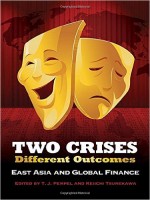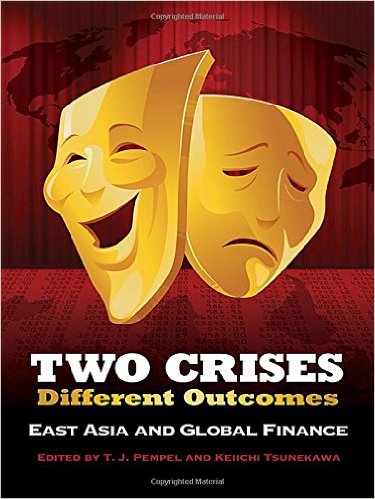 Part of the series: Cornell Studies in Political Economy (Series Editor: Peter J. Katzenstein)
Part of the series: Cornell Studies in Political Economy (Series Editor: Peter J. Katzenstein)
Editors: T.J. Pempel, and Keiichi Tsunekawa
Publisher: Cornell University Press – 267 pages
Book Review by: Sonu Chandiram
The 1997 ‘Asian Financial Crisis’ should have really been called the 1997-1998 Fareastern Asian Financial Crisis, as you will note from reading the sixth paragraph below.
It is interesting to note that, according to the International Monetary Fund, China’s growth of its gross domestic product was a total of nearly 238 percent in 24 years from 1990 to 2013. That works out to an impressive average annual GDP growth rate of 9.91 percent. China’s economy is now the fastest growing in the world.
A distant second in economic growth is India, with total GDP of around 150 percent for this 24-year period. That averages to only about 6.25 percent a year. But this is far faster than the growth of U.S. GDP which totaled only a little over 59 percent in 24 years and has averaged a lackluster 2.47 percent annually. Europe’s total growth was a dismal 32 percent in that period, and has averaged only 1.45 percent per year.
Moreover, neither China nor India had any down years from 1990 to 2013. For China, its best year was 2007 with a whopping 14.2 percent growth that year, and its worst one was 1990, with just 3.8 percent GDP growth, still about 50 percent higher than the U.S. average of 2.47 percent. India’s best year was also 2007, with 9.8 percent growth and its slowest year was 1991 with a snail-paced move of just 1.1 percent.
Comparatively, the United has experienced three years of a shrinking economy – 1991, 2008, and 2009, with the worst one being 2009 with a 2.8 percent contraction. Europe has had four economic downturns in that 1990-2013 period: in 1993,2009, 2012, and 2013, with the worst one being 2009 when its overall economy shrunk by 4.4 percent.
These comparative figures are provided in a table with 11 Asian countries, the United States, and Europe, on page 14 of this book as part of the Introduction. We wanted to provide this brief perspective to our readers so that they understand that while they know that the developed economies of the United States and Europe provide larger average incomes to its people, Asian nations are catching up. And in some places such as Singapore, its people make on average, more money than residents of some countries in Europe.
As you look at this table, one set of numbers (in 1998) sticks out sharply: the shrinking of the economies of seven of the 11 Asian countries. This was the aftermath of 1997 so-called ‘Asian Financial Crisis’. Those were the economies of Indonesia, Thailand, Malaysia, South Korea, Singapore, Japan, and the Philippines, that respectively contracted 13.1, 10.5, 7.4, 5.7, 2.2, 2.0, and 0.6 percent
The four exceptions were China, India, Vietnam, and Taiwan which had growth rates of 7.8, 6.2, 5.8 and 3.5 percent respectively by the end of 1998. So why was the 1997-1998 economic downturn named the Asian Financial Crisis when two of the fastest-growing Asian economies in the world – China and India – were not even affected? And two other countries, part of the Far East, were also not even affected? It rightfully should have been termed the 1997 Fareastern Asian Financial Crisis, as we state above.
This is an interesting book on that crisis, and what you will find in it, we give you an overview below.
- Introduction: Crises, Corrections, and Challenges
- Two Crises, Two Outcomes
- Part 1: Dealing with Crises: Continuities and Changes
- A Tale of the Two Crises: Indonesia’s Political Economy
- Unraveling the Enigma of East Asian Economic Resiliency: The Case of Taiwan
- Reacting to Financial Crises: Institutional Path Dependence in Korea and Thailand
- China and the Two Crises: 1997 to 2009
- Part 2: Toward a Second East Asia Miracle?
- Political Business and External Vulnerability in Southeast Asia
- Success as Trap? Crises and Challenges in Export-Oriented Southeast Asia?
- Japan: The Political Economy of Long Stagnation
- Conclusion: Toward a Second East Asia Miracle?
Much of the content for this book was derived from papers presented by attendees at two conferences – the first in September 2010, and the second in February 2012 – of the Japan International Cooperation Agency Research Institute (JICA-RI). These meetings were held to determine what were the causes of the 1997-1998 downturn in the seven countries.
Lastly, it is interesting to note that 2010 was a unique, and great year for Asia. Why? Because none the 11 Asian countries had a downturn that year. Japan’s economy grew the least among Asian nations that year, at 4.7 percent, much higher than Europe’s 2 percent and almost twice as much as the 2.5 percent growth rate of the U.S.
The tiny city-sate of Singapore expanded the most in Asia in 2010, by 14.8 percent. Taiwan and India grew at double-digit rates for the first time in the 24-year period, at 10.8 percent and 10.5 percent respectively, and China grew again for the 11th time since 1990 at a double-digit rate, at 10.4 percent.
Editors:
T.J. Pempel
Keiichi Tsunekawa
Contributors:
Muhammad Chatib Basri is minister of finance in the Republic of Indonesia and professor of economics at the University of Indonesia.
Yun-han Chu is distinguished research fellow at the Institute of Political Science at Academia Sinica.
Richard Doner is the Goodrich C. White Professor of Political Science at Emory University.
Barry Naughton is Sokwanlok Chair of Chinese International Affairs at the University of California, San Francisco.
Yasunobu Okabe is senior research fellow at the Japan International Cooperation Agency Research Institute.
T.J. Pempel is Jack M. Forcey Professor of Political Science in the Department of Political Science at the University of California, Berkeley.
Thomas B. Pepinsky is associate professor in the Government Department at Cornell University.
Keiichi Tsunekawa is senior professor at the National Graduate Institute for Policy Studies, Tokyo.







